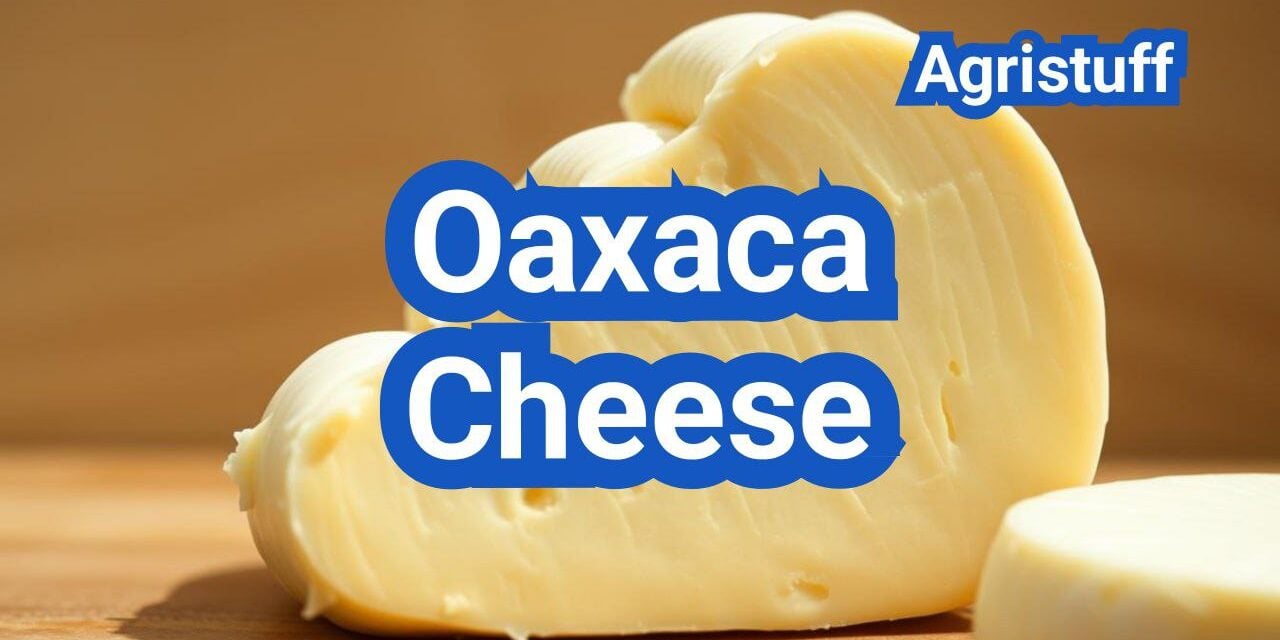Oaxaca cheese, also known as Quesillo Oaxaqueño, is a type of string cheese originating from Mexico ( mexican cheese ) . It is a staple in Mexican cuisine, known for its soft texture and mild flavor.
This cheese is made from cow’s milk and is often used in traditional dishes. Its production involves a careful process that gives it a unique taste and texture.
The Rich Heritage of Oaxaca Cheese
Oaxaca cheese, a staple in Mexican cuisine, has a rich history that dates back centuries. Originating in the state of Oaxaca, this traditional cheese is a testament to the region’s cultural heritage.
Origins in Southern Mexico
The production of Oaxaca cheese is deeply rooted in the state of Oaxaca, where it has been produced using traditional methods for generations. The cheese is made from cow’s milk, which is heated to a high temperature before being shaped into its characteristic form.
Oaxaca cheese is not just a product; it’s a symbol of the region’s cultural identity. It’s often served at family gatherings and celebrations, and its production is a source of pride for local communities.
What Is Oaxaca Cheese?
Oaxaca cheese, also known as Quesillo Oaxaqueño, is a type of string cheese that originates from the Oaxaca region in Mexico. This cheese is known for its soft, white, and stringy texture, making it a staple in many traditional Mexican dishes.
Characteristics of Oaxaca Cheese
Oaxaca cheese is characterized by its mild flavor and creamy texture. It is often used in dishes such as quesadillas, tlayudas, and other savory recipes. The cheese is made from cow’s milk and is known for its versatility in both traditional and modern Mexican cuisine.
Cultural Significance
In Mexican cuisine, Oaxaca cheese holds a significant cultural value. It is a symbol of the country’s rich culinary heritage and is often served at family gatherings and celebrations.
Types of Oaxaca Cheese

Oaxaca cheese, also known as Quesillo, is a staple in Mexican cuisine. It is known for its creamy texture and mild flavor, making it a favorite among locals and visitors alike.
Traditional Quesillo
Traditional quesillo is made using a centuries-old technique that involves stretching and folding the curd. This labor-intensive process results in a cheese that is both flavorful and versatile.
Regional Variations
Different regions in Mexico have developed their own variations of Oaxaca cheese. These regional cheeses may have distinct flavors and textures, reflecting local preferences and production methods.
By understanding the different types of Oaxaca cheese, one can appreciate the complexity and diversity of this traditional Mexican product.
The Complete Guide to Oaxaca Cheese Processing Steps
Oaxaca Cheese processing is an artisanal craft that begins with careful milk selection and preparation. The quality of the milk directly impacts the flavor and texture of the final product.
Milk Selection and Preparation
The production of Oaxaca Cheese starts with the selection of fresh, high-quality milk. Traditionally, cow’s milk is used, but some variations may include a mix of cow and goat’s milk. The milk is heated to a specific temperature to prepare it for the curdling process.
Curdling Process
The curdling process involves adding a coagulant to the heated milk. This causes the milk to separate into curds and whey. The type of coagulant used can vary, with some producers preferring vegetable rennet for a more traditional flavor.
Acidification Techniques
After curdling, the curds undergo acidification, which involves allowing them to sit for a period to develop a tangy flavor. This step is crucial for developing the characteristic taste of Oaxaca Cheese.
The Malaxation Process
Malaxation is a critical step where the curds are stretched and pulled apart, creating the cheese’s signature strings. This process not only develops the texture but also enhances the flavor.
| Processing Step | Description | Importance |
|---|---|---|
| Milk Selection | Choosing high-quality milk | Directly impacts flavor and texture |
| Curdling | Adding coagulant to separate curds and whey | Crucial for texture development |
| Acidification | Allowing curds to develop tangy flavor | Essential for characteristic taste |
| Malaxation | Stretching and pulling curds apart | Creates signature strings and enhances flavor |
By following these steps, producers can create authentic Oaxaca Cheese that is both delicious and true to its traditional roots.
Essential Equipment for Making Oaxaca Cheese

Oaxaca Cheese production involves an array of essential equipment, including both traditional and modern elements. The choice of equipment can significantly impact the quality, texture, and flavor of the final product.
Traditional Tools
Traditional tools play a vital role in the production of authentic Oaxaca Cheese. Some of the key traditional tools include:
- Wooden spoons for stirring and handling the curd
- Cheesecloth or manta cloth for draining and shaping the cheese
- Handheld stretchers for kneading and stretching the curd
Modern Machinery
Modern machinery has revolutionized the Oaxaca Cheese production process, improving efficiency and consistency. Some of the modern machinery used includes:
- Automated curd cutters for precise curd cutting
- Mechanical stirrers for uniform heating and curd distribution
- Pneumatic presses for consistent pressure application
Cooker-Stretcher Systems
Cooker-stretcher systems are specialized equipment designed to streamline the cooking and stretching processes in Oaxaca Cheese production. These systems:
- Combine cooking and stretching into a single process
- Allow for precise temperature control
- Enable consistent stretching and texturizing of the cheese
The integration of traditional tools and modern machinery, including cooker-stretcher systems, allows cheesemakers to produce high-quality Oaxaca Cheese while maintaining its cultural heritage.
The Science Behind Oaxaca Cheese Stretch
The unique stretchiness of Oaxaca cheese is a result of its complex protein structure. The casein proteins in Oaxaca cheese are arranged in a way that allows for maximum elasticity.
When heated, the protein network unwinds, resulting in a smooth and pliable texture. This characteristic makes Oaxaca cheese a favorite among cheese enthusiasts.
The science behind Oaxaca cheese’s stretchiness is rooted in its protein structure. The casein molecules form a complex network that provides the cheese with its elasticity and melting properties.
Understanding Oaxaca Cheese Melt Properties
Oaxaca Cheese is renowned for its excellent melt properties, making it a staple in many Mexican dishes. The melt properties of Oaxaca Cheese are influenced by factors such as pH level and moisture content.
The ideal pH range for Oaxaca Cheese is between 5.5 and 6.5, allowing for a smooth and even melt. Moisture content also plays a crucial role, as higher moisture levels can result in a cheese that melts more easily.
| Factor | Influence on Melt Properties |
|---|---|
| pH Level | Affects the melting point and texture of the cheese |
| Moisture Content | Influences the meltability and creaminess of the cheese |
By understanding the factors that influence the melt properties of Oaxaca Cheese, you can unlock its full potential in your recipes.
Oaxaca Cheese vs. Mozzarella: A Detailed Comparison
Oaxaca Cheese and Mozzarella cheese are two popular cheeses with distinct differences in terms of flavor, texture, and usage. Understanding these differences is crucial for choosing the right cheese for various recipes.
Flavor Profile
Oaxaca Cheese is known for its mild, creamy flavor, while Mozzarella has a milder taste that can range from milky to sharp. The flavor profile of Oaxaca Cheese is more pronounced, with a richer, more buttery taste.
Texture
Oaxaca Cheese is characterized by its stringy, melted texture, making it perfect for dishes where a gooey texture is desired. Mozzarella, on the other hand, can range from soft and creamy to firm, depending on its age.
Culinary Applications
Both cheeses are versatile and can be used in a variety of dishes. Oaxaca Cheese is commonly used in traditional Mexican cuisine, such as quesadillas and tlayudas. Mozzarella, with its mild flavor, is a staple in Italian cuisine, used in pizzas, caprese salads, and other dishes.
Nutritional Profile of Oaxaca Cheese
Oaxaca cheese is a nutrient-rich food that provides a range of health benefits when consumed in moderation. A serving size of approximately 28 grams contains around 100-120 calories.
| Nutrient | Amount per 28g Serving |
|---|---|
| Calories | 100-120 |
| Protein | 6-7g |
| Calcium | 200-250mg |
The nutritional benefits of Oaxaca cheese make it a valuable addition to a balanced diet. However, due to its high caloric and fat content, it should be consumed in moderation.
Where to Buy Authentic Oaxaca Cheese in the U.S.

Discovering where to buy authentic Oaxaca cheese in the U.S. can enhance your culinary adventures. Authentic Oaxaca cheese is now more accessible than ever, available at various outlets across the country.
Specialty Mexican Markets
Specialty Mexican markets are a treasure trove for those seeking authentic Oaxaca cheese. These stores typically carry a wide range of Mexican products, including artisanal cheeses. Visiting these markets can be a rewarding experience, as they often source their products directly from Mexico, ensuring authenticity.
Major Grocery Chains
Many major grocery chains now carry Oaxaca cheese, recognizing its growing popularity. Check the international or specialty cheese section in stores like Whole Foods, Trader Joe’s, or larger supermarkets with diverse dairy sections.
Online Retailers
The convenience of online shopping has made it easier to purchase Oaxaca cheese from the comfort of your home. Online retailers such as Amazon, Walmart, and specialty food websites often carry a variety of Oaxaca cheese products. When shopping online, be sure to check the seller’s reviews and product descriptions to ensure you’re getting an authentic product.
As the demand for Oaxaca cheese continues to grow, it’s becoming increasingly easier to find authentic products. Whether you prefer shopping in-store or online, there are numerous options available for those looking to experience the rich flavors of Oaxaca cheese.
Top Oaxaca Cheese Substitutes

Finding the right substitute for Oaxaca Cheese is crucial for maintaining the authenticity of Mexican recipes. When Oaxaca Cheese is not available, several alternatives can be used, including other Mexican cheeses and non-Mexican options.
Similar Mexican Cheeses
Mexican cuisine offers a variety of cheeses that can substitute for Oaxaca Cheese. Some of the most suitable alternatives include:
- Asadero Cheese: Known for its mild flavor and creamy texture, Asadero Cheese is an excellent substitute in many recipes.
- Queso Fresco: Although it’s crumbly, Queso Fresco can be used in dishes where a lighter texture is acceptable.
- Queso Panela: This cheese has a mild flavor and can be melted, making it a good substitute in certain dishes.
These cheeses, while not identical to Oaxaca Cheese, share similar characteristics that make them viable substitutes in Mexican cooking.
Non-Mexican Alternatives
For those without access to Mexican cheeses, non-Mexican alternatives can be used. Some options include:
- Mozzarella Cheese: Known for its melting properties, Mozzarella can be used as a substitute in many recipes that call for Oaxaca Cheese.
- Monterey Jack Cheese: This semi-soft cheese has a mild flavor and melts well, making it a suitable alternative.
- String Cheese: In a pinch, string cheese can be used, especially in dishes where the cheese is melted or stretched.
While these cheeses are not traditional Mexican cheeses, they can effectively substitute for Oaxaca Cheese in various recipes.
In conclusion, while Oaxaca Cheese is unique, there are several substitutes available, both within and outside of Mexican cuisine. By choosing the right alternative, you can maintain the flavor and authenticity of your dishes.
Proper Storage and Handling of Oaxaca Cheese

Maintaining the quality of Oaxaca Cheese requires careful consideration of storage and handling practices. Proper storage not only preserves the cheese’s unique flavor and texture but also extends its shelf life.
Temperature and Humidity Considerations
The storage of Oaxaca Cheese is significantly influenced by temperature and humidity levels. Ideally, Oaxaca Cheese should be stored in a cool environment with a consistent refrigerator temperature between 39°F and 41°F (4°C to 5°C). High temperatures can cause the cheese to spoil quickly or become too soft and oily.
Humidity control is equally important. A humid environment helps maintain the cheese’s moisture content. The ideal relative humidity for storing Oaxaca Cheese is between 80% and 90%. This can be achieved by storing the cheese in a sealed container or wrapping it tightly in plastic wrap or aluminum foil.
Extending Shelf Life
To extend the shelf life of Oaxaca Cheese, it’s crucial to handle it properly. Always handle the cheese with clean hands or utensils to prevent contamination. When storing, keep the cheese away from strong-smelling foods, as Oaxaca Cheese can absorb odors easily.
Here are some additional tips for extending the shelf life:
- Store Oaxaca Cheese in the refrigerator at the appropriate temperature.
- Keep it wrapped tightly to prevent drying out.
- Avoid freezing, as it can alter the texture and flavor.
- Consume the cheese within a few weeks of opening.
| Storage Method | Temperature | Humidity | Shelf Life |
|---|---|---|---|
| Refrigerated | 39°F – 41°F (4°C – 5°C) | 80% – 90% | Several weeks |
| Wrapped in plastic/aluminum foil | 39°F – 41°F (4°C – 5°C) | 80% – 90% | Several weeks |
Step-by-Step Guide to Making Homemade Oaxaca Cheese

Making homemade Oaxaca Cheese is a rewarding process that allows you to enjoy this delicious Mexican cheese fresh from your own kitchen. With a few simple ingredients and some basic equipment, you can create a product that’s both authentic and delicious.
Ingredients and Equipment Needed
To start making Oaxaca Cheese, you’ll need the following ingredients and equipment:
- 1 gallon of whole milk
- 1/4 tsp mesophilic cheese culture
- 1/4 tsp vegetable rennet
- 1 tsp salt
- Cheese making equipment: large pot, thermometer, cheese cloth, colander
Optional equipment: cheese stretcher or wooden spoon for stretching the curd.
Preparation Process
The preparation process involves several key steps:
- Heat the milk to 86°F (30°C) and add the mesophilic cheese culture. Allow it to ripen for 45 minutes.
- Add the rennet and let the mixture coagulate for about 30 minutes, or until it reaches a clean break.
- Cut the curd into 1/2-inch pieces and let it sit for 10 minutes.
- Cook the curds at 100°F (38°C) for 30 minutes, stirring occasionally.
- Drain the curds in cheese cloth and let them cool.
Stretching and Forming Techniques
The stretching process is crucial for developing Oaxaca Cheese’s characteristic texture:
Stretching: Heat water to 170°F (77°C). Submerge the curds in hot water for a few seconds, then remove and stretch until smooth. Repeat this process several times until the curd becomes shiny and stretchy.
Forming: Once stretched, form the cheese into a ball or rope. Immediately submerge it in cold water to set the shape.
| Step | Description | Temperature |
|---|---|---|
| 1. Ripening | Add culture, let sit | 86°F (30°C) |
| 2. Coagulation | Add rennet, let coagulate | 86°F (30°C) |
| 3. Cooking | Cook curds | 100°F (38°C) |
| 4. Stretching | Stretch curds in hot water | 170°F (77°C) |
Classic Mexican Dishes Featuring Oaxaca Cheese

Oaxaca cheese is a staple in Mexican cuisine, and its creamy texture makes it a perfect addition to various traditional dishes.
Quesadillas
Quesadillas are a classic Mexican dish made by filling tortillas with Oaxaca cheese and cooking them until crispy and melted. To make quesadillas, simply place a tortilla in a pan, add shredded Oaxaca cheese, and cook until the cheese is melted and the tortilla is crispy.
Tlayudas
Tlayudas are a traditional Oaxacan dish consisting of a large, crispy tortilla topped with beans, cheese, and various meats. To make tlayudas, bake or fry a tortilla until crispy, then top it with refried beans, Oaxaca cheese, and your choice of meats or vegetables.
Queso Fundido
Queso fundido is a Mexican fondue made with melted cheese, chorizo, and served with tortillas. It’s a fun and interactive dish perfect for gatherings and parties.
Modern Culinary Applications for Oaxaca Cheese
Oaxaca cheese is a versatile ingredient that can elevate a variety of dishes, from traditional Mexican cuisine to modern fusion creations. Its creamy texture and mild flavor make it an ideal addition to many recipes.
Fusion Cuisine Ideas
One of the most exciting ways to use Oaxaca cheese is in fusion cuisine. By combining it with ingredients from other culinary traditions, you can create unique and delicious dishes. For example, try pairing Oaxaca cheese with Korean chili flakes to create a spicy, savory sauce perfect for topping tacos or using as a dip.
Elevating Classic Recipes
Oaxaca cheese can also be used to add a new dimension to traditional recipes. Use it in place of other cheeses in mac and cheese, or as a topping for baked potatoes. The melted cheese adds a rich, creamy texture that complements a variety of flavors.
Creative Recipe Ideas
- Oaxaca Cheese Quesadillas: Fill tortillas with Oaxaca cheese, diced chicken, and sautéed onions for a twist on traditional quesadillas.
- Cheesy Grilled Corn: Grill corn on the cob and top it with crumbled Oaxaca cheese, chili powder, and a squeeze of lime juice.
By incorporating Oaxaca cheese into your cooking, you can add a touch of Mexican flavor to your dishes and explore new culinary possibilities.
Embracing the Versatility of Oaxaca Cheese
Oaxaca Cheese is a treasure trove of flavors and textures, offering a world of possibilities for culinary creativity. Its unique characteristics make it an ideal ingredient for various dishes, from traditional Mexican recipes to modern fusion cuisine.
The versatility of Oaxaca Cheese lies in its meltability, stretch, and rich flavor profile, making it a valuable addition to many kitchens. Whether you’re preparing classic quesadillas, experimenting with new recipes, or simply looking to elevate your cooking, Oaxaca Cheese is an excellent choice.
By understanding the different types, processing steps, and equipment used to make Oaxaca Cheese, you can unlock its full potential and explore new ways to incorporate it into your cooking. As you’ve discovered throughout this article, the possibilities are endless, and the results are sure to delight.
Embracing the versatility of Oaxaca Cheese can take your culinary creations to new heights, and we hope this guide has inspired you to get creative with this incredible ingredient.
FAQ
What is Oaxaca Cheese?
Oaxaca Cheese is a type of Mexican string cheese that originated in the southern region of Oaxaca. It is known for its creamy texture and mild flavor.
What is the history of Oaxaca Cheese?
Oaxaca Cheese has a rich heritage dating back to the indigenous communities of Southern Mexico. The cheese was traditionally made from cow’s milk and was an important part of the local cuisine.
What are the different types of Oaxaca Cheese?
There are several types of Oaxaca Cheese, including traditional, artisanal, and commercial varieties. The traditional type is made from cow’s milk, while artisanal varieties may include other milks such as goat’s or sheep’s milk.
How is Oaxaca Cheese made?
Oaxaca Cheese is made through a process of curdling, stretching, and shaping. The curd is heated and stretched to create a smooth, stringy texture.
What are the nutritional benefits of Oaxaca Cheese?
Oaxaca Cheese is a good source of protein, calcium, and other essential nutrients. It is also relatively low in fat and calories compared to other types of cheese.
How do I store Oaxaca Cheese?
Oaxaca Cheese should be stored in the refrigerator at a temperature below 40°F (4°C). It can be wrapped in plastic wrap or aluminum foil to prevent drying out.
Can I make Oaxaca Cheese at home?
Yes, Oaxaca Cheese can be made at home with the right equipment and ingredients. It requires a cheese-making kit, milk, and a thermometer.
What are some popular dishes that use Oaxaca Cheese?
Oaxaca Cheese is a versatile ingredient that can be used in a variety of dishes, including quesadillas, tlayudas, and empanadas.
Can I substitute Oaxaca Cheese with other types of cheese?
While other types of cheese can be used as substitutes, Oaxaca Cheese has a unique flavor and texture that is difficult to replicate. Mozzarella or Monterey Jack cheese can be used as substitutes in some recipes.
Where can I buy Oaxaca Cheese?
Oaxaca Cheese can be found in many Mexican markets, specialty cheese shops, and online retailers. It is also available in some larger grocery stores that carry a variety of international cheeses.
Conclusion of: Oaxaca Cheese
Oaxaca cheese: a quick introduction
Oaxaca cheese is a fresh, semi-soft pasta-filata (stretched-curd) cheese known for its buttery flavor, clean dairy aroma, and dramatic stringy pull; Oaxaca cheese is traditionally formed into long ribbons that are wound into a tidy ball and is prized by Mexican cooks and U.S. home kitchens alike for superior melt and stretch. Academic overview of Oaxaca cheese (SciELO)
Oaxaca cheese, quesillo, and regional naming
Across Mexico, Oaxaca cheese is widely called “quesillo” or “queso de hebra” (string cheese), and Oaxaca cheese retains deep roots in central valleys markets where vendors braid or ball its silky strands; in the U.S., Oaxaca cheese labeling usually follows the Spanish or English name while keeping the same stretched-curd identity. Quesillo vs. queso Oaxaca (El Financiero)
The origin story many tell about Oaxaca cheese
A popular account holds that Oaxaca cheese was discovered in the late 19th century in Reyes Etla when over-acidified curd was “rescued” by hot water, revealing the elastic fiber that defines Oaxaca cheese; whether apocryphal or precise, the tale situates Oaxaca cheese in the dairying towns northwest of Oaxaca City. Background on the history of Oaxaca cheese
How Oaxaca cheese fits among pasta-filata cheeses
Technologically, Oaxaca cheese belongs to the pasta-filata family alongside mozzarella and provolone, yet Oaxaca cheese differs in salting, hand-stretching, and final form (ribbons or braids) that create a gentle, creamy chew; in sensory studies, Oaxaca cheese balances buttery notes with light tang better than many cousins. Peer-reviewed profile of Oaxaca cheese
Types and formats you’ll find for Oaxaca cheese
In markets, Oaxaca cheese appears as classic balls, braided “trenzas,” or hand-pulled ropes, and Oaxaca cheese may be crafted from raw or pasteurized cow’s milk by artisans or produced by modern dairies; in U.S. retail, Oaxaca cheese often comes in balls, strips, or shreds designed for quick melting in everyday cooking. Everyday uses for Oaxaca cheese (Milk Street)
Processing steps: how Oaxaca cheese is made
From a process standpoint, Oaxaca cheese starts with high-quality cow’s milk cultured and set with rennet; Oaxaca cheese curd is cut and gently cooked, rested to reach the target acidity, then immersed in 60–75 °C hot water or whey where Oaxaca cheese curd is kneaded and stretched into smooth ribbons before cooling and light salting. Stretching pH effects in pasta-filata cheeses (JDS)
Critical controls: acidity and temperature for Oaxaca cheese
For reliable stretch, Oaxaca cheese makers watch pH and heat closely: Oaxaca cheese typically plasticizes near pH ~5.2–5.4, and curd must be heated sufficiently for proteins to align without becoming grainy; too high a pH or too cool a bath and Oaxaca cheese won’t develop the signature pull. Mozzarella stretching science applicable to Oaxaca cheese
Essential equipment for crafting Oaxaca cheese
At small scale, Oaxaca cheese production relies on a stainless vat, curd knives, accurate thermometers, a pH meter, perforated ladles, and hot-water baths for stretching; at plant scale, Oaxaca cheese uses cooker-stretcher and molding systems that automate kneading, temperature, and fiber formation to keep texture consistent. Industrial cooker-stretchers for Oaxaca-style cheeses
The stretch: why Oaxaca cheese pulls into silky strands
During hot-water working, Oaxaca cheese casein micelles partially demineralize and uncoil, then align into fibrous bundles under kneading, giving Oaxaca cheese its long, peelable threads; the balance of calcium loss, heat, and work determines whether Oaxaca cheese forms glossy ribbons or breaks. Protein interactions during stretching (JDS)
Melt behavior: how Oaxaca cheese softens and flows
Fresh Oaxaca cheese melts cleanly and, over refrigerated storage, Oaxaca cheese often exhibits slightly increased meltability as minor proteolysis softens the matrix; research on Oaxaca cheese shows predictable changes in pH, texture, and melt across 1–3 weeks when packaged correctly. Quality changes of Oaxaca cheese during storage
Food safety and sanitary rules for Oaxaca cheese
Whether artisanal or industrial, Oaxaca cheese must meet sanitary norms from milk reception to packaging—clean milk, robust heat controls, traceability, and hygiene are essential to safe Oaxaca cheese; Mexico’s NOM-243 outlines key microbiological and processing requirements for dairy products including Oaxaca cheese. NOM-243 sanitary specification (dairy)
Labeling and authenticity standards for Oaxaca cheese
Because imitation products exist, Oaxaca cheese labels matter: Mexican NOM-223 defines how cheeses, including Oaxaca cheese, must be denominated, labeled, and composed—rules that help buyers distinguish true Oaxaca cheese from analog cheese products in markets. NOM-223 denomination & labeling for cheese
Nutritional snapshot of Oaxaca cheese
Like similar semi-soft cheeses, Oaxaca cheese provides high-quality protein, calcium, and fat, and Oaxaca cheese typically clocks in around ~80–100 kcal per ounce with ~6–7 g protein (brand-dependent); for specific labels, U.S. shoppers can consult FoodData Central entries on Oaxaca cheese. USDA FoodData Central search for Oaxaca cheese
Traditional Oaxacan dishes featuring Oaxaca cheese
In its homeland, Oaxaca cheese is essential in tlayudas—giant tortillas layered with beans, asiento, meats, and plenty of Oaxaca cheese—and Oaxaca cheese also stars in quesadillas, memelas, and queso fundido that showcase its gentle salt and luxurious stretch. Tlayuda context from Gobierno de México
Best Mexican dishes in the U.S. for Oaxaca cheese
For American kitchens, Oaxaca cheese shines in quesadillas de flor de calabaza, chiles rellenos, enfrijoladas or enmoladas, and skillet queso fundido with rajas or chorizo; Oaxaca cheese’s mild flavor lets salsas, beans, and roasted peppers take the lead while adding that signature pull. Ideas for cooking with Oaxaca cheese (Milk Street)
How to melt Oaxaca cheese like a pro
For perfect quesadillas, keep Oaxaca cheese inside the tortilla and use moderate heat: warm a tortilla, add Oaxaca cheese to half, fold, cover to trap steam, and flip once for even melt—this simple method preserves moisture so Oaxaca cheese stretches without leaking fat. Quesadilla technique (Serious Eats)
Substitutions and pairings for Oaxaca cheese
If you can’t find it, Oaxaca cheese substitutes include low-moisture mozzarella or young Monterey Jack, though Oaxaca cheese remains unmatched for stringy pulls; for pairings, Oaxaca cheese loves roasted poblanos, squash blossoms, black beans, epazote, and bright salsas. What is Oaxaca cheese? (Bon Appétit)
Buying tips: choosing authentic Oaxaca cheese
When shopping, look for clean milky aroma and a supple, peelable ribbon structure that signals careful stretching, and make sure Oaxaca cheese labels indicate real “queso” (not “imitación”); a federal consumer study in Mexico has tested Oaxaca cheese quality versus imitations to guide buyers. Government quality study on Oaxaca cheese
Scaling from artisan to industrial Oaxaca cheese
As demand grows, producers scale Oaxaca cheese with continuous cooker-stretcher and molding lines that standardize kneading, temperature, and fiber development while preserving the signature character of Oaxaca cheese; steam-assisted stretching helps meet volume without sacrificing texture. Industrial stretching systems (GEA)
Quality, packaging, and storage for Oaxaca cheese
To keep texture pristine, Oaxaca cheese benefits from vacuum packing or tight wrapping that limits moisture loss and oxidation, and once opened Oaxaca cheese should be rewrapped in breathable paper plus a bag and used within 1–2 weeks; freezing is not recommended because Oaxaca cheese can lose its signature stringiness. Storage & quality changes in Oaxaca cheese
Food labeling and consumer protection for Oaxaca cheese
For clarity in markets, Oaxaca cheese descriptions and ingredient declarations must match standards so consumers get true milk-based Oaxaca cheese rather than starch- or oil-based analogs; Mexico’s NOM-223 and related enforcement underpin confidence at retail for Oaxaca cheese buyers. Cheese denomination standard (NOM-223)
Final thought
From family mercados to U.S. supermarkets, Oaxaca cheese delivers comfort and craft in every peelable ribbon—respect the pH, the heat, and the handwork, and Oaxaca cheese will reward you with the meltiest quesadillas, the stretchiest fundidos, and a delicious entry point into Oaxacan food culture. Deeper reading on artisanal Mexican cheeses (JDS)
Sources & References
- Domínguez-López et al., overview of Oaxaca cheese (SciELO)
- Villanueva-Carvajal et al., “Oaxaca cheese: flavour, texture and their interaction”
- Effect of stretching pH on pasta-filata cheeses (Journal of Dairy Science)
- Fuentes et al., quality changes of Oaxaca cheese during storage (JDS/PubMed)
- NOM-223-SCFI/SADER-2018 denomination & labeling for cheese
- Gobierno de México: tlayuda & quesillo context
- Tetra Pak: cooker-stretcher systems
- GEA: steam stretching machines
- Serious Eats: The Food Lab’s quesadilla method
- Bon Appétit: What is Oaxaca cheese?
- USDA FoodData Central: Oaxaca cheese search
- El Financiero: naming of quesillo/Oaxaca cheese
- El Financiero: history & origin of Oaxaca cheese
- JDS review of artisanal Mexican cheeses










